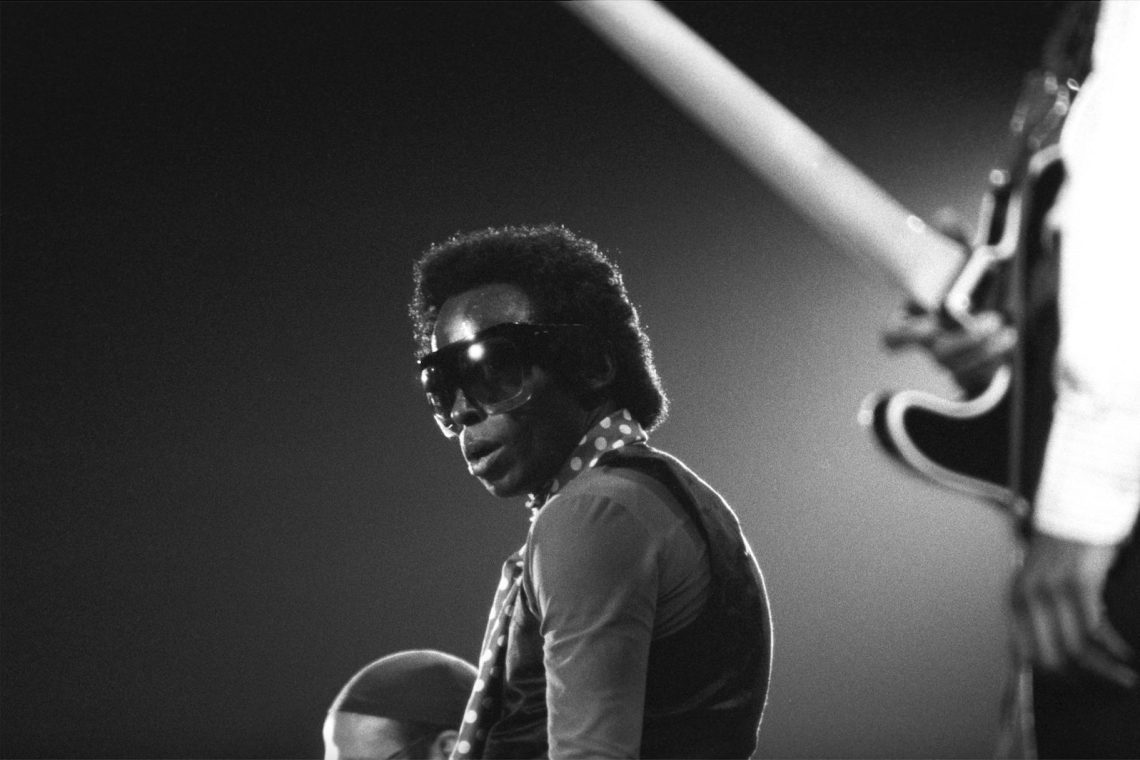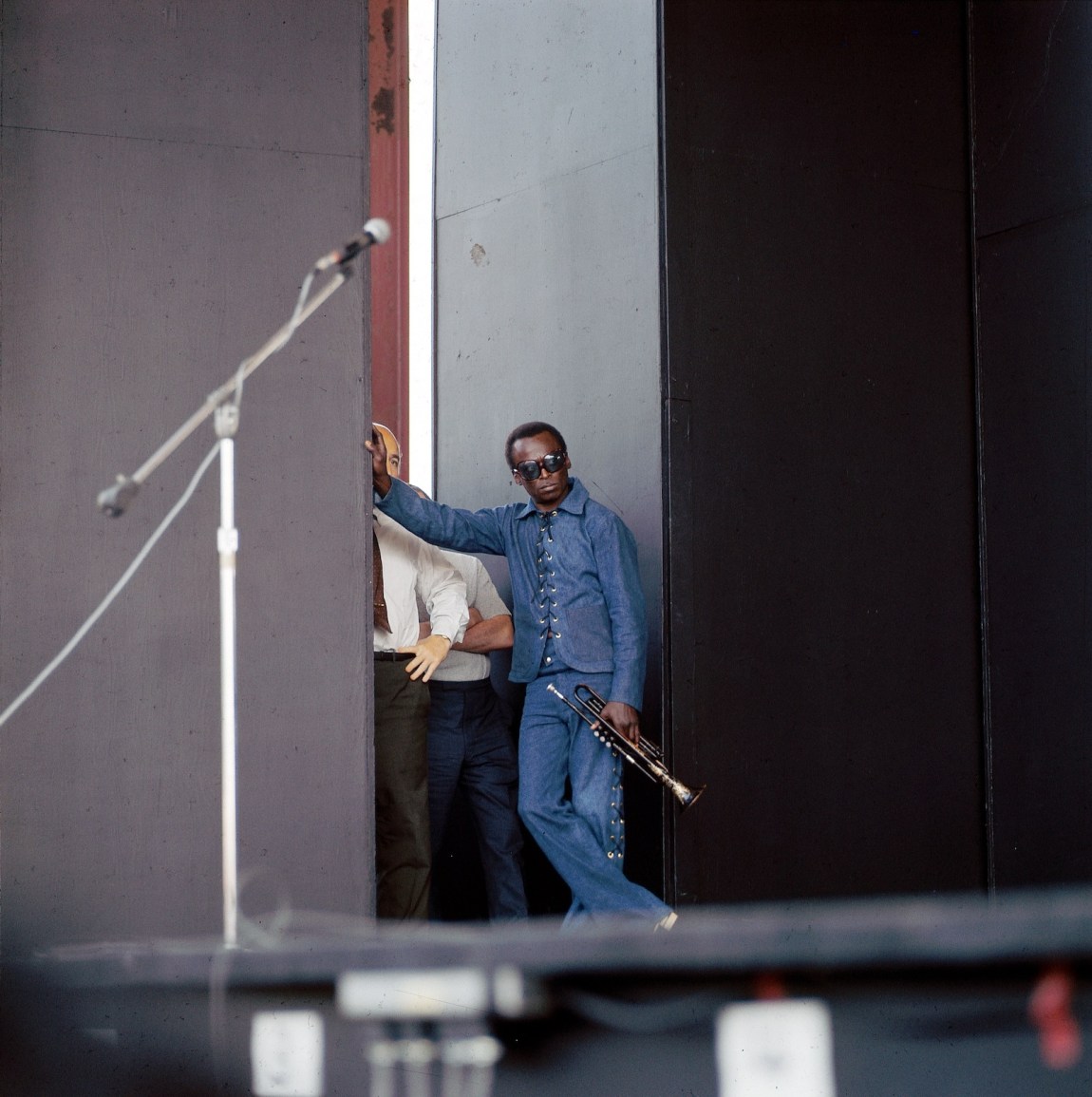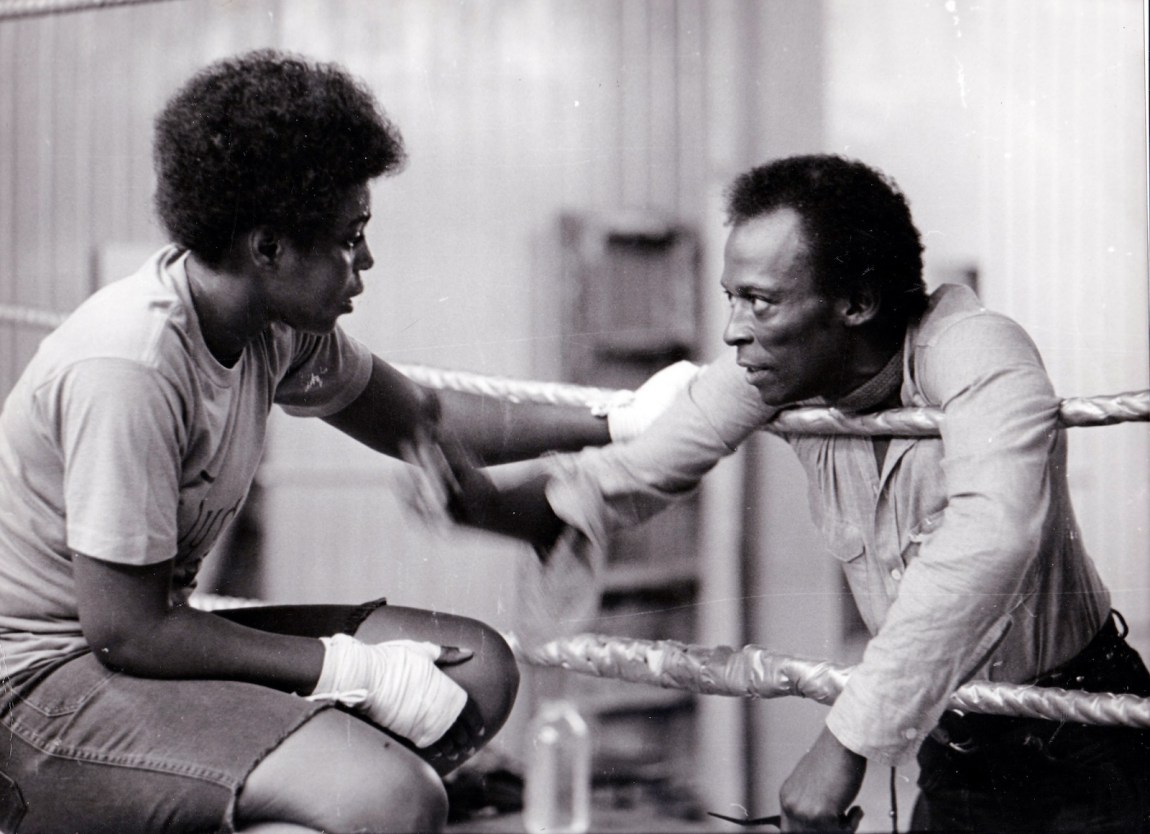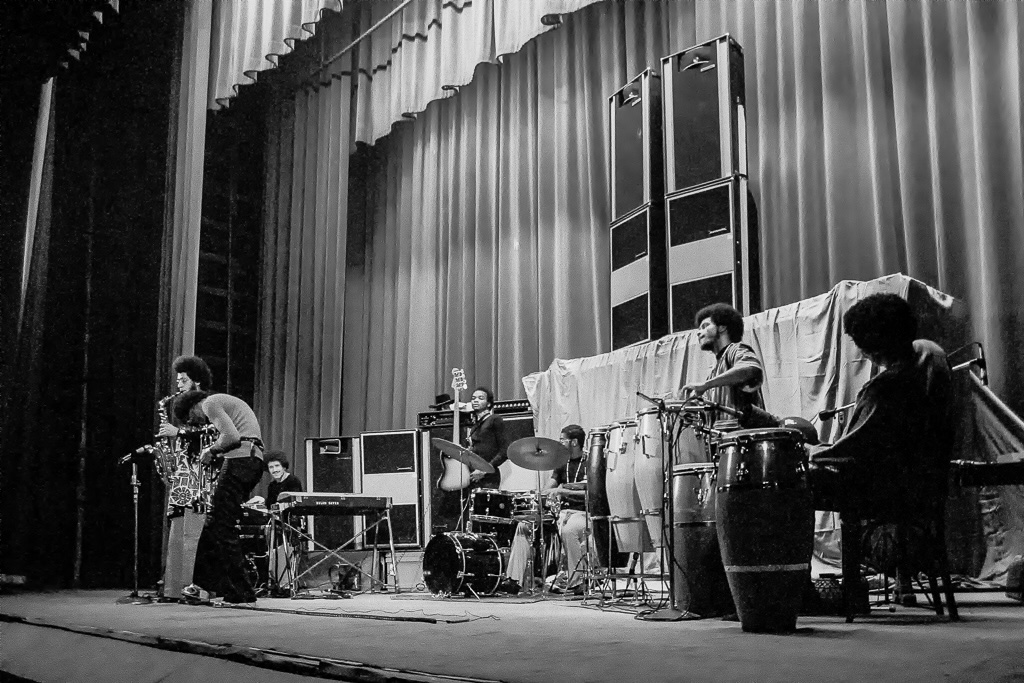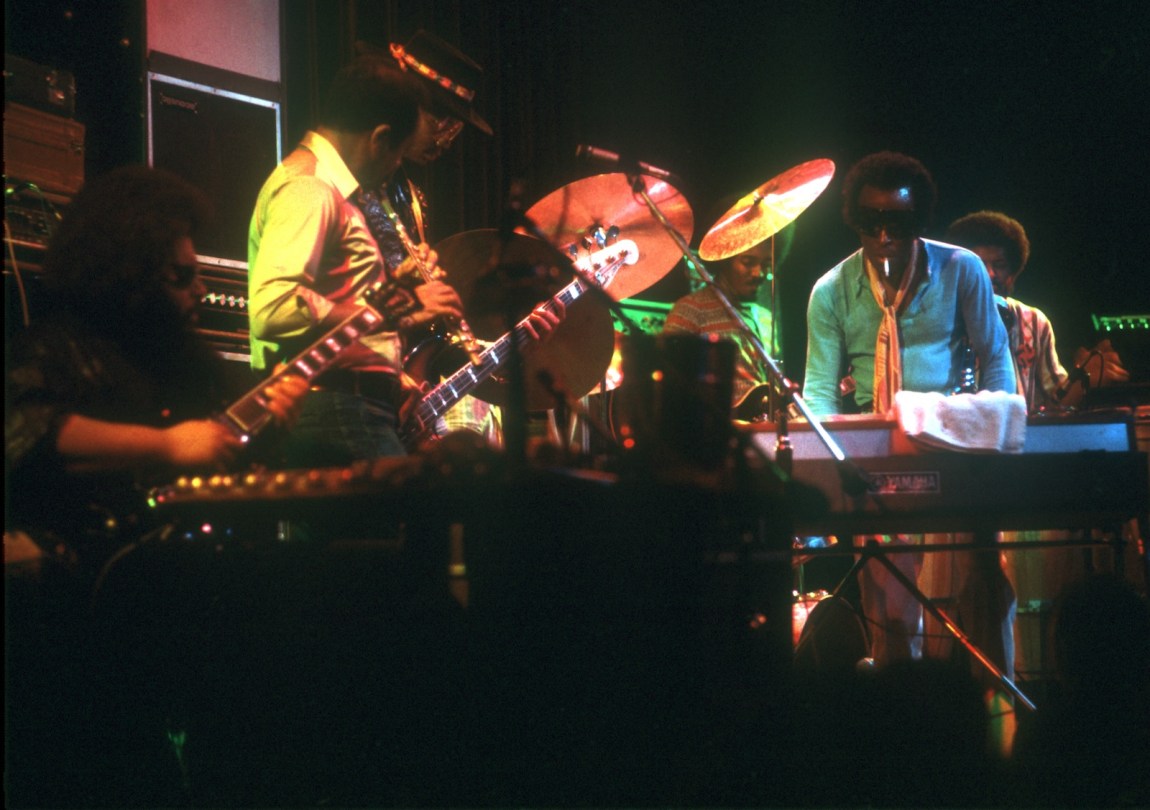In 1968 Miles Davis let his second quintet dissolve. He no longer needed a small working band, the stable unit of semi-equals that had been customary both to his way of doing things and to the jazz tradition as a whole. He’d passed forty and had likely revised his ideas about what a “band” even was, what a “work” was, and what the “jazz tradition” was. Further, he felt that genres and their repertoire were instruments of racial determinism: “jazz” was an Uncle Tom word; “soul” connoted any singer whose voice white people would like theirs to resemble; “rock” meant white people singing about liberating white people. He identified with Black music as a set of practices and dispositions that transcended copyright and ownership, and he himself owned a five-story building on West 77th Street.
Across the first twenty years of his career, Davis had figured out his specific positions and coordinates—tone, phrasing, sense of harmony and space—and at some point during the mid 1960s he worked in a different way: he faded back, or perhaps advanced, as if to become an environment. As an artist, he dissolved into his work: not quite absenting himself, or not only that, but diffusing himself throughout. He moved in the direction of creating, let’s say, systems that would self-generate music, or that he could switch on and switch off, with which he could engage and disengage. Once the system was in place, his job was to assemble its players and feed it bits of input. “All I did,” he said in his autobiography regarding Bitches Brew (1970) and Live-Evil (1971), “was get everyone together and write a few things.”
This tendency had grown over time: in 1965, onstage with his second quintet at the Plugged Nickel in Chicago for a two-week stretch, he led his tunes toward unbroken continuities, subverting and exploding them, as his band remixed them over and over. Two years later, at Columbia Studios, the Miles Davis Quintet recorded “Pee Wee,” written by the drummer Tony Williams, released on Sorcerer (1967). Davis did not play on the track at all—not a known practice for a jazz bandleader.
But he still needed to make records for Columbia. These were both a primary source of income and a generative source of tension and irritation, as he jousted with executives about budgets and schedules and marketing and cover art. He made and released eleven albums in a six-year stretch between 1969 and 1975. Four were live, one (Live-Evil) was assembled from both live and studio recordings, and the other six were studio records: In a Silent Way (1969), Bitches Brew, A Tribute to Jack Johnson (1971), On The Corner (1972), Big Fun (1974), and Get Up With It (1974). The dates refer to when each was released, not when they were recorded. Davis seemed to have another kind of order in mind.
*
On May 17, 1968, at Columbia Studios in New York, Davis asked Ron Carter to switch from his usual upright bass to electric bass for recording a track called “Stuff.” Presumably Davis wanted stronger, simpler vamps to go up against Tony Williams’ soul-boogaloo drum pattern. “Stuff” was the start of something, but it was a hip failure, awkward and draggy. Besides, Carter generally did not want to be playing electric bass. Soon after, though apparently not for that particular reason, he quit the group; his departure helped set into motion the quintet’s dissolution.
For about a dozen years, Davis had been one of the rare subjects of fascination and controversy within the tradition of jazz for people outside that tradition. (He keenly hated the word “jazz,” but whatever it is, he was central to it.) Restlessness was part of his self-identity, as was a desire for a greater market share, although he did not strictly want to attend to his audience’s desires. Though his records were often considered the height of taste, the state of the art, et cetera, the power and commercial success he’d commanded across race and genre and nationality with Kind of Blue (1959) and Sketches of Spain (1960) were not repeated with the second quintet.
Which is perhaps why he eventually took a suggestion from the record producer Clive Davis: to play on concert bills with rock bands. This involved amplification. If you were insulted by the sound of amplified instruments, well, then, for you his music ended there. But amplification for Davis wasn’t about making music dominating and trendy and feckless. It was about bringing layered drumming and danceable rhythms to the top and adjusting the volume of other instruments accordingly. On stage, with a wireless microphone attached to his trumpet, he could roam and act as conductor. Delay and reverb brought out more colors in his tone.
Davis’s desire for amplification may have also been about assuming majesty rather than asking for space. He aspired to be the sort of successful artist who could make the ensembles and records and concerts that he wanted, when he wanted, such that he didn’t particularly have to worry about marketing, audiences, and critics; such that a lot of people might listen and perhaps be taken aback or love it, but he would not necessarily care if they did not—because it was not his job to care, only to keep experimenting.
Advertisement
*
Davis maintained a control and a proprietary aura over his group’s sound even as he added volatile ingredients to it. He’d done this trick in 1949 with the Birth of the Cool sessions, enlisting the collaborative work of the arranger Gil Evans, who filtered bebop through a soft, slow, surreal soundscape. He’d done it in the mid-1950s by tendering something called, after the fact, “hard bop”: a clean and tight version of small-group bop, bluesier and less hectic, with deeper grooves. He formed a band for this purpose—his “first quintet”—into which he dropped the pianist Red Garland, whose gestures were neat as a pin, and the tenor saxophonist John Coltrane, a wild card on a spiritual quest whose playing poured over the edges. (“A more unpromising group of mismatched musicians could hardly be imagined,” remarked the critic Gerald Early, in hindsight.) He did it by bringing the pianist Bill Evans and alto player Cannonball Adderley into his small band for Kind of Blue, which gave a very ancient sound—medieval modes—mass appeal.
But in the late 1960s he stepped up this practice, admitting enormous amounts of new information into his groups. Electric keyboards, two or three of them at a time. Two basses at a time. Two drummers at a time. Two electric guitarists at a time. Between 1968 and 1974 he enlisted more than forty musicians for his sessions. Some were better known for playing in idioms that weren’t, strictly speaking, his own: funk, rock, Hindustani classical. Some were very young, or little known.
He gathered groups for union-regulated, three-hour, morning-into-afternoon recording sessions for which the players often had very little idea what particular song they were working on, or even what kind of song, or to what end. Davis encouraged them toward discovery by removing the possibility of completion and preventing anyone from having the last word. A famous example of this was his directive to the guitarist John McLaughlin during the Silent Way sessions: “Play it like you don’t know how to play the guitar.” This is how a composition by the pianist Joe Zawinul with a governing chordal movement became a harmonically static track on a Miles Davis album that sounds as if it is based on memory: a half-remembered melody and a drone.
Davis’s new methods of organized spontaneity meant that more work was done after the fact, tape-editing and restructuring, largely by his producer, Teo Macero. If the increasing density and disjunction of the music still carried traces of the jazz tradition, it did not reduce at all to free jazz, the primary established form of 1960s disjunction. Davis was cutting loose from forms in general. He no longer needed the tradition’s typical harmonic changes (his science), or standards (his library), or ballads (his emotional specialty), or anything like the thirty-two-bar song form. The old division of concepts between albums disappeared. By 1974 or so, he was playing less and less trumpet and more and more keyboards: treated, echoey, clustered.
When this music hit the market, many artists from his own generation—Charles Mingus, Thad Jones—found it misguided or simply confusing. All sorts of people lined up to call him a provocateur, a sellout, a race traitor. Even as he inveighed against white treachery and desired to attract Black listeners, the Amsterdam News, New York’s most widely distributed Black paper, accused him in 1971 of making “popularized, electrified, bastardized, free form whiteboy-rock pseudo-black music.” The title of that article was “Miles Davis, Won’t You Please Come Home.”
But by then Davis was long gone. The destabilization of norms was precisely what he wanted. “Jazz” was the least of it. He was complicating received ideas of provenance and repetition and authorship. And like many great musicians, he did it in a way that made you, as a listener, feel that you could step into his system and engage in it yourself.
*
Paul Buckmaster was a young English composer and arranger, a classical cellist who moved in experimental music circles and worked on pop records. When Buckmaster first met Davis in London in the fall of 1969, he had recently arranged the strings on David Bowie’s “Space Oddity” and would soon to do on Elton John’s “Your Song.” He was also part of the Third Ear Band, which played lengthy, improvised, drone-oriented pieces, sometimes in very public places, such as when they’d opened for the Rolling Stones in Hyde Park earlier that year. In a receptive mood, Davis heard a tape of Buckmaster’s music, a “thirty-odd-minute continuous piece,” Buckmaster later wrote, “for which I had provided some thematic material, and a repetitious bass and drums riff.” Davis remarked that it was similar to Bitches Brew, which he was working on at the time. A friendship began.
Advertisement
Two and a half years later, in the spring of 1972, Davis called Buckmaster to New York to help him work on some new music. Their collaboration, in one way or another, yielded parts of “Ife,” on Big Fun, and some of the flow and shape of On The Corner. While staying at Davis’s house, Buckmaster played him a recording of Karlheinz Stockhausen’s Mixtur — likely the one released on Deutsche Gramophone in 1969 with Telemusik on the other side, a fashionable record at the time. Mixtur is a piece for orchestra and live electronics, open to real-time modification; the 1969 recording includes a short, startling, staccato trumpet passage about four minutes in. Buckmaster noted that it sounded like something Davis would play.
Later during his stay, Buckmaster practiced the prelude of Bach’s first suite for solo cello. (Though Davis’ interests and affections could pass quickly, he talked about Stockhausen and Bach in interviews for some years thereafter.) Buckmaster once shared an idea with Davis that came to him while listening to Stockhausen’s Hymnen, which involves recorded national anthems and bursts of radio static, as if the composer is tuning between stations. Buckmaster, as quoted in Paul Tingen’s book, Miles Beyond:
I said something to Miles like, “Things are either on or off. Reality is made of a sequence of on and offness.” A crazy idea. But what I meant was that a sound doesn’t mean anything unless it has a silence preceding it or coming after it, or next to it. Silence makes up part of music, it is in music, and that’s what I was trying to get at.
In his autobiography, Davis writes something similar about his thoughts during that period: “Through Stockhausen I understood music as a process of elimination and addition. Like ‘yes’ only means something after you have said ‘no.’”
When I asked Teo Macero about Paul Buckmaster’s role in Miles Davis’ records during that time, Macero said “nothing.”
*
Two of these records were made in memory of the dead. A Tribute to Jack Johnson is memorable for Billy Cobham’s shuffle rhythms, McLaughlin’s unobscured electric-guitar power, and Davis’ tart, punching trumpet phrases. It was made to accompany a documentary about the heavyweight-champion boxer Jack Johnson. Davis was a fanatic watcher of boxing and, more recently, a participant in it, often working out at Gleason’s Gym on Westchester Avenue in the South Bronx. He identified with Johnson, who died the year before Davis led his first recording session. In a text written for the record’s release, Davis enthused:
He was a fast-living man; he liked women—lots of them and most of them white. He had flashy cars because that was his thing.… He smoked cigars, drank only the best champagne and prized a 7 ft. bass fiddle on which he’d proudly thump jazz. His flamboyance was more than obvious. And no doubt mighty Whitey felt “No Black man should have all this.”
Davis’ second-to-last paragraph strings together two thoughts related to death: “Dig this—The fight he lost (1915) in Havana was rumored to be thrown—Jack Johnson died like he lived—in a fast car (1946—age 68).” As John Szwed surmised in his biography, So What, Davis might have been floating the notion that he was “throwing” his career by acquiescing to the wishes of Clive Davis and Columbia Records, making music for white people while collecting more money for doing it than ever before.
In 1953, during a detour in Detroit, addicted to heroin, Davis may have narrowly avoided dying at twenty-seven. In 1959 he suffered head wounds from a police officer’s club outside Birdland for refusing to move out of the middle of the sidewalk. By 1961 he was experiencing a wasting of the hip due to sickle-cell anemia, which caused him tremendous pain. By the spring of 1965 he couldn’t walk, and underwent surgery on his left hip bone, wiping three months of gigs off his schedule; four months later he broke his left leg. In 1966 he was hospitalized for a liver infection. In October 1969, driving his girlfriend Marguerite Eskridge after a concert in Brooklyn, his car was shot at—by a mobster? A dealer? Nobody knows—and a bullet grazed his left hip. In October 1972 he broke both ankles in a car accident. By the time of the final sessions for Get Up With It, he’d recently had pneumonia and a heart attack.
Get Up With It is dedicated to Duke Ellington, who had died six months before its release. Its two poles are the dense, driving, acrid, fractured tape construction “Rated X,” and “He Loved Him Madly,” a thirty-two-minute long-homage to Ellington that sounds nothing like Ellington: organ drones and echo-laden shards of minor scales, unplaceable for its first third until it settles into a slow, quiet groove, with flute and trumpet and guitar seeming to accompany a transitory feeling. It slithers, nearly formless even when it assumes a kind of form.
The arranger Sy Johnson, who moonlighted as a jazz journalist, visited Columbia’s Studio B just after the “He Loved Him Madly” recording session had ended. Davis and others were listening to a playback. Writing up the experience in Jazz magazine, Johnson described the track as “thick Spanish funereal music.” Later that day, he visited Davis at his Upper West Side apartment for a tense interview, during which Davis explained his music of this whole six-year period better than anyone ever has:
I think it’s time people changed where they put the melody. The melody can be in the bass, or a drum sound, or just a sound. I may write something around one chord. I may write something around a bass line. I may write something around a rhythm…. I always place the rhythm so it can be played three or four different ways. It’s always three rhythms within one, and you can get some other ones in there too.
Later in the piece, Johnson notices that Davis—worn, ailing, reclining on the couch with one sock off—had a “dime-sized hole on the knuckle of his middle toe.”
*
In a 1955 essay, the French critic Roland Barthes explored the idea of “désinvolture” in recent French crime films like Touchez pas au grisbi (1954). Désinvolture means the offhand, the unconstrained; the translator Richard Howard rendered it in English as “cool,” with quotation marks. Barthes decided that as a mode of communication, désinvolture was a matter of power through understatement and muted signals, saying by barely saying, imposing one’s will by barely lifting a finger. In these films, wrote Barthes,
Facts which ordinary philosophy still judges to be considerable, such as the death of a man, are reduced to a blueprint, presented in the volume of a tiny gesture: a minor disturbance in the peaceful movement of lines, two fingers snapped, and at the other end of the perceivable field a man falls in the same manner of movement.1
In désinvolture Barthes saw a “universe of litotes.” Litotes has come to mean understatement in general, but in classical literature it specifically refers to a convention of understatement through double negative, as in Vergil’s Sixth Eclogue: “Non iniussa cano” (I do not sing the unbidden). Litotes enlarges possibility; it also undoes binaries. If I admire an idea because it’s “not unreasonable,” I’m not just saying it’s reasonable. I’m saying that its strength lies somewhere between the land of reason and non-reason, and such a land doesn’t exist in binary logic. Nothing suggests litotes in purer form than death. The dead are not with us. They are also not-not with us. In this state they move fast, they slip around.
*
Davis booked sessions at Columbia Studio B, on East 52nd Street, or Studio C, on East 30th Street; he gave his musicians vague instructions, sometimes with chords or ideas written on paper, sometimes sung or tapped out on his body. Once they started, Teo Macero recorded everything.
Macero was a saxophonist and composer who came with his own ideas. He had studied with the composers Edgard Varèse and Henry Brant in the 1950s, experimented with tape-edit constructions, written antiphonal compositions for multiple orchestras to be performed simultaneously from different parts of the theater, stage, and mezzanine. Starting in 1957, he became a “music editor” at Columbia Records. He worked alongside an engineer, as he told me forty years later, and if the engineer’s job was to get all the sounds on tape accurately, Macero’s was to “make sure the pieces all fit together.” That meant following scores while listening closely and paying attention to the composer’s and conductor’s intentions.
Whether or not Macero was in the studio when the music was recorded, he made sure the recording attained the fixed idea of what was wanted, even if that meant clashing with the conductor or composer. It was his job to understand the piece in its ideal state and to insist that the recording meet that ideal, possibly through editing and splicing. “You’d take out all the mistakes,” he remembered, “and you’d have a good run-in with Isaac Stern or Bernstein or whatever, and make the performance almost perfect.… I would say, ‘OK, we have to fix that B-flat, let’s see if we can find that B-flat somewhere.’”
But starting with Davis’s In a Silent Way, his brief changed. There, Macero edited forty-plus minutes of improvised music down to thirty-three, then expanded those up to thirty-eight by repeating sections. In that case and others going forward, there was no previously agreed-upon idea. Macero expressed his willingness to edit all these sessions of jamming without a macro-form down into a structure. Davis assented. Macero told me and practically everyone else who interviewed him a variation on the same thing: In twenty-five years of working together, Davis only came to the editing room five times or so.
Davis seemed to know that Macero was unusual in his knowledge of music. He also seemed to know that Macero was creative and headstrong and able to move beyond company-man values. Macero, for his part, seemed to know that Davis had brilliant instincts and insights, as well as a profound restlessness and lack of patience. Davis needed someone in his corner, but not someone in love with his hipness. Macero told me that Davis was “very strange.” But Macero was also very strange. He was a foil: curious and abrasive and driven and appreciative. Davis gave Macero creative recklessness. Macero gave Davis creative organization.
*
The albums blur together but they also retain some of their own individual character. In a Silent Way is prelude music: tentative, vulnerable, bespelled by its own daring, reluctant to lock into a method. Bitches Brew, Davis’s first double album, is the trendiest and most fraught. It came loaded with Columbia’s budget and expectations; it has claims to make and minds to blow; and so the rhythms can achieve a mannered groove, as Davis’s lines and gestures often clap their hands in front of you. Jack Johnson is (mainly) strutting, stark, blunt, lean. Live-Evil, well-rehearsed and reckless, flings itself forward, attaining newly rich and deep blends of sound while importing the feel of Black vanguardist pop, particularly Hendrix’s Band of Gypsys (1970) and Sly Stone’s mountaintop tracks: “Dance to the Music,” “Thank You,” “I Want to Take You Higher.” On The Corner seems a more direct thought-experiment: What if James Brown’s “Say It Loud—I’m Black and I’m Proud,” Stockhausen’s Hymnen, and the flute melodies of various indigenous peoples were integrated by the same receptors? Big Fun is anachronistic and centerless, relaxing and lengthening Davis’ ideas between 1969 and 1972; half of it stays quiet enough for the papery twangs of berimbau, tamboura, and sitar to be heard. Get Up With It, in its cryptic drift and density, its heavy fog, its indirection, keeps an oblique relationship with performance, entertainment, and intention. It is extraordinarily haunted.
Drumming became paramount, in greater accretions: trap set and percussion and sometimes tablas. The rhythm became orchestral and would carry a melody. There was at times an emphasis on multiple keyboards (played by Zawinul, Chick Corea, Keith Jarrett, Herbie Hancock), then on multiple electric guitars (Reggie Lucas, Pete Cosey, Dominique Gaumont). No more of the old democratic order of soloists: over time, it would become Davis on trumpet and just a few others—a saxophonist, a guitarist, floating to the surface over “songs” or “tracks” or simply long performances, spliced or uncut.
Davis had been known for playing slow ballads, but he also valued the power of speed in short spaces, particularly before disappearance. His trumpet mentor in East St. Louis, Elwood Buchanan, taught him to play without vibrato; that was a regional thing, in Davis’ account, but also a method of alertness, a way of slipping in and out of a phrase rather than staying and shaking a note. (“You can’t help but play fast if you approach the trumpet like he does,” Davis told the drummer and music journalist Don DeMichael in 1969.) Davis saw himself as a fast boxer by virtue of his body type—“small legs and round shoulders”—and believed that other boxers saw him that way, too. He liked fast cars: They made their point and then vanished. He liked disappearing from music before anyone expected, especially if he was surrounded by people who tend to stay there, who play on and on. You can hear this fascination on Live/Evil: abrupt stops to frenetic pieces, like “What I Say”; a style of trumpet soloing that jabs and then cuts off before finishing a phrase; long stretches, like most of the twenty-three-minute “Funky Tonk,” where Davis can’t be heard.
By 1972 Davis had become his own perfect keyboardist. He held down clustered chords on an electronic organ that could blot the music, or insert notes into it like sharp points. These sounds were a form of désinvolture: they guaranteed a fresh and alien quality. He didn’t overthink them. He could even give them away; it didn’t matter, because they were his. “I just play it for Dave [Liebman] and different little sounds and shit,” Davis told Sy Johnson. “Reggie [Lucas] can play the same things that I can play. I taught him to make the same sounds.”
This new music wasn’t “jazz.” But it wasn’t “rock” either. Nor was it “funk” or really anything else. Better to use litotes. It was not not jazz (the disjointed slow ballad “Gemini”), rock (the roadhouse shuffle “Right Off”), ambient music (“Nem um Talvez”), noise (the extreme welter of “Rated X”), blues (“Red China Blues” or the slow middle section of “John McLaughlin”), funk (“One and One”), dub (the slow middle section of “Calypso Frelimo”). Some of those imprecise designations are for genres that evolved long before this period, and some are for genres that hadn’t really evolved yet.
*
As copyrighted material, plenty of Miles Davis tunes can be asterisked. “Solar” (1954; the opening bars of its melody are inscribed on his tombstone at Woodlawn Cemetery in the Bronx) replicates the line from Chuck Wayne’s “Sonny” (1946). The three-chord figure in “Mademoiselle Mabry” (1968) sounds related to the three-chord figure in Jimi Hendrix’s “The Wind Cries Mary,” released fourteen months earlier. The first four bars of the written theme to “Donna Lee” (May 1947) closely resemble the first four bars of his friend Fats Navarro’s trumpet solo on “Ice Freezes Red” (January 1947). “Tune Up” (1953) and “Four” (1954) may have been written by Eddie Vinson. Some of the music on Filles de Kilimanjaro (1968), for which Davis claimed sole composer credit, seems to have been written with or by Gil Evans.
This practice appears both ethically dubious and logical, or even almost honorable, from a jazz-tradition point of view.2 Like many jazz musicians, Davis adapted familiar melodic themes and put them to new purposes. It was as if he could take a little musical construction, clock its inner essence, drain it, and remake it via a minor modification. But Davis also did this to himself. On the level of composition, his “All Blues” of 1959 is, through a harmonic adjustment, a slowed-down cousin to his own “Milestones” of 1958. On the level of improvisation, his solo on “So What” in March 1959 repeats a considerable amount from the third chorus of his solo on “It Ain’t Necessarily So” from July 1958—any reasonably attentive fan could sing along with it.
On the level of postproduction, something weirder was going on. Macero created repetitions within a song: most famously with “In a Silent Way,” which repeats its first four minutes in its final four minutes, to create the after-the-fact impression of a recapitulating form; but also in smaller instances, such as “Pharaoh’s Dance” on Bitches Brew, where shorter repetitions are made for no clear reason. (Between eight and a half and nine minutes in, you’ll hear a section repeated via tape splicing; you can tell because a voice somewhere within it says “Hey, Jim” twice, in the same way.)
The repetitions weren’t only intra-song, they were inter-album. In “Yesternow,” on A Tribute to Jack Johnson, during the thirteenth minute, a minutelong excerpt from “Shhh/Peaceful” from In a Silent Way, an album released two years earlier, drops into the mix. This was not an alternate take or a “reprise” version (as the Beatles did on Sgt. Pepper’s and Hendrix on Electric Ladyland), or an ironic back-referencing, as the Beatles had also done in “All You Need Is Love,” when they start to sing the chorus of “She Loves You.” It was a chunk of music that had already been on the market for a little while, torn out of its old context and put into a new one.
How to understand that gesture? It wasn’t a recognized practice. Did it create value? It wasn’t “padding”—they didn’t need it; they had plenty of new session material. To a certain way of thinking, it is an eccentric choice. But perhaps not for a musician who’d coopted his friend’s solo and a producer who intimately knew Varèse’s Poème électronique. The name of the piece sort of says it all. Did Davis name it “Yesternow”? No: his hairdresser, James Finney, did.
*
In an interview with Leonard Feather in 1971, Davis repeatedly and insightfully talks about cliché. For instance: “It’s easy to play a cliche. A cliché should be your musical foundation, but it shouldn’t be what you do.”
Where is the origin point of Davis’s conception of himself as engaged in perpetual resistance to cliché? His autobiography lingers over possible moments. One is the day in 1944 or 1945 when he’s sitting in a music history class at Juilliard as a white teacher explains that Black people sang the blues “because they were poor and had to pick cotton.” Davis, as he relates it, raised his hand, stood up, and said: “I’m from East St. Louis and my father is rich, he’s a dentist, and I play the blues. My father didn’t never pick no cotton and I didn’t wake up this morning and start playing the blues. There’s more to it than that.”
For Davis there was often more to it than that. He grasped the perniciousness of “that”—felt it intuitively. “That” was his enemy; it meant whatever has attained thingness, canonization, consecration, a hardening into what goes without saying, a line that grows corny or an idea borrowed only to protect the givens in the world. The thing about fighting against “that” is that almost nobody will help you, because “that” gets you ahead, makes you money, integrates you. You have to fight against “that” yourself, in your own way. You better know it down cold, but then slip away.


